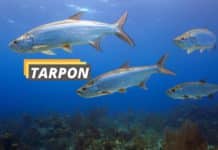The different types of bass species are separated into two classes – black bass and temperate bass. Though some may look the same, there are key differences that make them unique. And, knowing their difference can help you decide if you what you are reeling is legal or not.
What Are the Different Types of Black Bass?
There are nine black bass species, boasting different number of rays and spines and vertical blotches. Out of the different types of bass, largemouth bass and smallmouth bass are the most popular because they are highly aggressive and their wide range.
As a matter of fact, black bass occupy a vast range, predominantly in the east of the Rocky Mountains. You can also find them as far as Northeastern Mexico and Canada.
Black bass are a freshwater species that occupy a vast range, predominantly in the east of the Rocky Mountains. However, you can also find this type bass as far as Northeastern Mexico and Canada.
Fun fact: Black bass species are members of the sunfish family. They are called “black bass” for their dark coloration and/or markings.
Alabama Bass
| Scientific Name | Micropterus henshalli |
| Other Names | N/A |
| Appearance | Jaw aligns with middle rear of the eye, goldish in color, dark blotched lateral line with spots below, and tooth patch on tongue. |
| Average weight and length | 2-5 pounds and 15 to 24 inches |
| Habitat | Rivers, reservoirs, and impoundments |
| Range | Mississippi, Georgia, Alabama, and Virginia and South Carolina |
| Spawning Season | March-April |
| Conservation Status | Invasive species outside Georgia and Alabama |
Alabama Bass are extremely similar in appearance to largemouth bass and often found in the same waters throughout their range. However, this type of bass is invasive, meaning they compete with largemouth and other species for prey and habitat.
If you want to catch this bass, you can find them in shallower water, as well as in murky to clear waters. Fish along areas of structure is also recommended since they ambush their prey.
During the pre-spawning season in March, using baits like spinnerbaits, crankbaits, swimbaits, flukes, and chatter baits is ideal. As the temperatures continue to warm, you can switch to topwater lures such as buzzbaits, soft plastic frogs, mice, and poppers.
Florida Bass
| Scientific Name | Micropterus salmoides floridanus |
| Other Names | Florida largemouth bass |
| Appearance | Silvery white, green, light brown with a broad blotchy black lateral line, and green-black specks on sides |
| Average weight and length | 5-12 pounds and 17-24+ inches |
| Habitat | Lakes, rivers, ponds with lots of structure and shallow depth |
| Range | Peninsular Florida |
| Spawning Season | Spring when the water temp reaches 60 degrees Fahrenheit |
| Conservation Status | Unknown |
Florida Bass are essentially the southern version largemouth bass. However, they grow much larger than their northern counterparts, making them a highly sought-after sport fish.
They can be caught using similar methods to other freshwater bass species. By fishing areas of structure with a variety of baits like spinners, plugs, frogs, crankbaits, and soft plastics you’ll find the most success.
Guadalupe Bass
| Scientific Name | Micropterus treculi |
| Other Names | Black bass, Guadalupe Spotted Bass, Texas trout |
| Appearance | Green in color, coloration extends lower on the body than other basses, non-vertical stripes, and the jaw does not extend past eyes |
| Average weight and length | ½ to 1 pound and 8-12 inches |
| Habitat | Rivers and streams |
| Range | Only found in Texas |
| Spawning Season | March-June |
| Conservation Status | Rare species |
The Guadalupe Bass is actually only found in the state of Texas. It is also smaller than the other types of bass it shares physical similarities with. And, unlike the Alabama Bass, this black bass specie is protected. This means there is a limited harvest and you can only use a line and pole to catch one.
Largemouth Bass
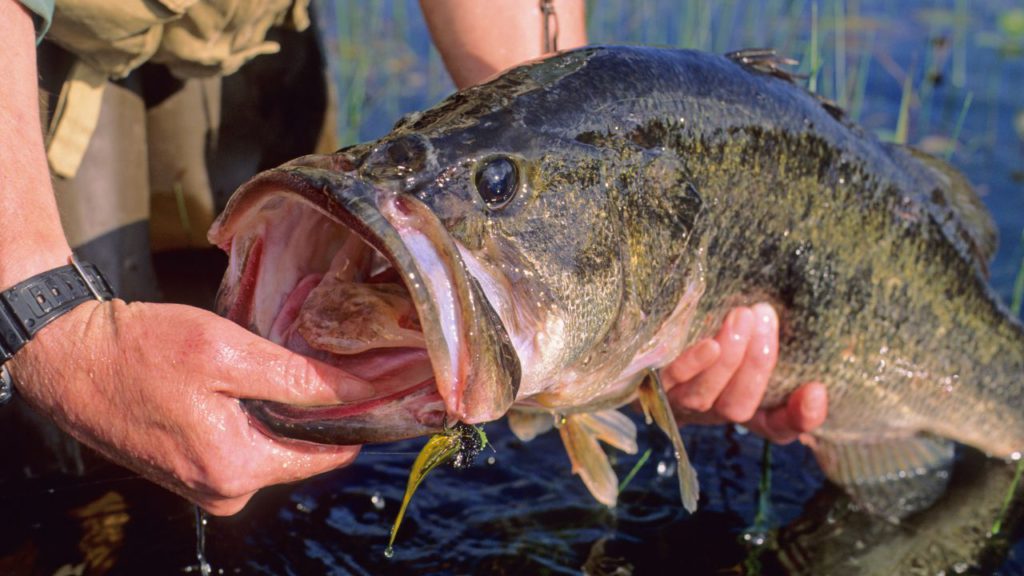
| Scientific Name | Micropterus salmoides salmoides |
| Other Names | Bucket Mouth, Bigmouth bass, Mossback |
| Appearance | Upper jaw extends far past the eyes, green, light olive, or even grayish in color with blotchy dark lateral line (visibility varies) |
| Average weight and length | 1-5 pounds and 13-20 inches |
| Habitat | Rivers, lakes, and ponds with abundant vegetation and structure, warm water |
| Range | New York, Great Lakes Region, Southern Quebec to Minnesota and South to the Gulf |
| Spawning Season | Spring (May-June) |
| Conservation Status | Least concern |
The northern Largemouth Bass is the smaller counterpart of the Florida Bass. This species of bass is incredibly popular for casual anglers and tournament anglers because they are highly aggressive.
This warm-water fish can be caught on virtually anything from worms and live bait to artificial lures. Chatterbaits, flukes, swimbaits, poppers, and frogs are great to use when fishing for them — they’ll hit just about anything and they’re a phenomenal fish to catch on topwater baits!
Redeye Bass
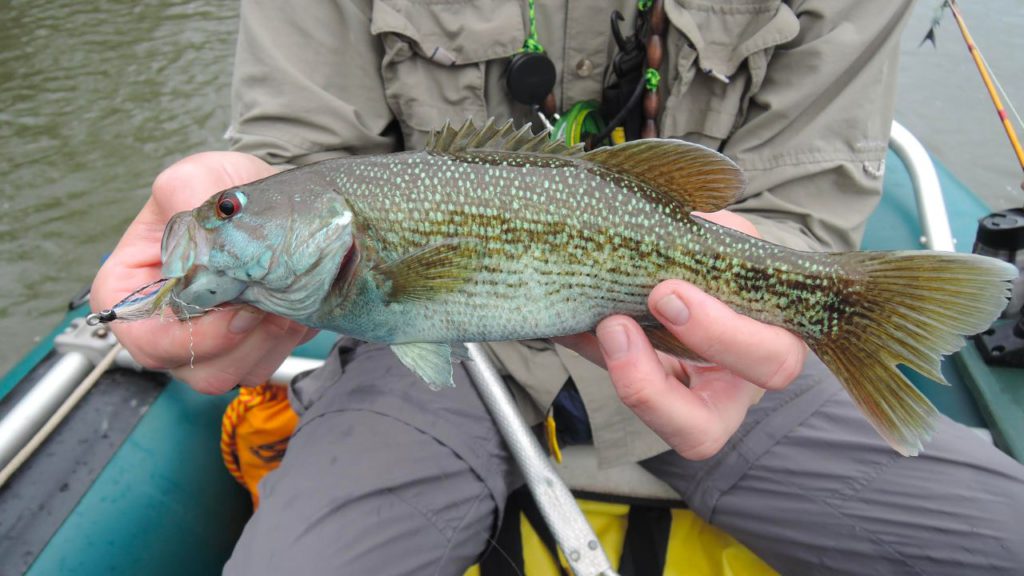
| Scientific Name | Micropterus coosae |
| Other Names | N/A |
| Appearance | Red eyes and fins, brownish-green in color with vertical bars on body, the jaw does not extend past eyes |
| Average weight and length | 6 ounces to 1 pound and 6-9 inches |
| Habitat | Rivers and streams with a structure like vegetation, boulders, and submerged logs |
| Range | California, Kentucky, South Carolina, Alabama, Georgia and Tennessee |
| Spawning Season | May-June |
| Conservation Status | Least concern |
Redeye Bass is a small and somewhat rare type of bass within its range. Plus, they are easy to identify because, as its name suggests, of their red eyes.
These small predators are primarily found in any body of water that has a current, like small rivers and streams. They can be found around rocky structures and in cooler, deeper water. Redeyes typically feed on insects, crayfish, and smaller fish.
When Redeye Bass fishing, you’ll often find success using lighter and smaller tackle like small spinnerbaits, spoons, and plugs. A live worm on a hook is always an alternative option if you want to use live bait as well.
Shoal Bass
| Scientific Name | Micropterus cataractae |
| Other Names | Shoal bass, Flint River smallmouth, Chipola redeye |
| Appearance | First and second dorsal fins connected, the jaw does not extend past eye, “tiger stripe” vertical lines above lateral line |
| Average weight and length | 1-4 pounds and 12-18 inches |
| Habitat | Rivers and large creeks, structures like rocks, docks, pilings, sunken logs, and drop-offs |
| Range | Alabama, Florida, and Georgia |
| Spawning Season | April-May and early June |
| Conservation Status | Vulnerable |
Shoal Bass is a rare larger species of bass that you can find in some rivers and creeks within its native range. They are unfortunately listed as vulnerable which means their population is likely declining due to various factors. As such, it is encouraged that anglers practice catch and release with this species of bass.
When you’re fishing for shoal bass it is best to fish areas where there is a rocky bottom, intersecting currents, and overhanging structures like bushes or trees. They typically feed on insects, insect larvae, crayfish, and fish.
Using baits that mimic their natural prey will help you to find success. However, using worms, topwater lures, and spinners are likely to catch them too.
Smallmouth Bass
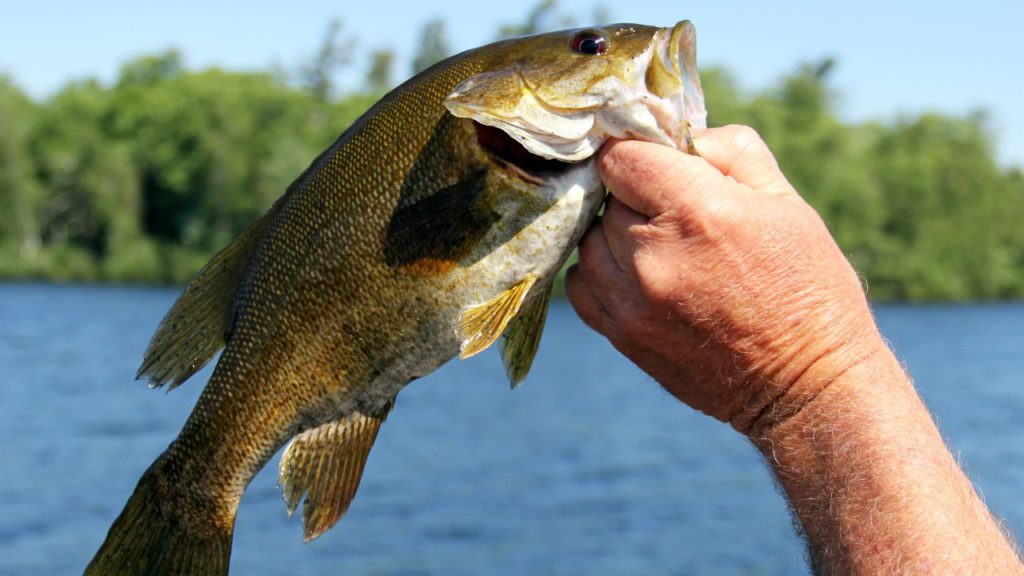
| Scientific Name | Micropterus dolomieu |
| Other Names | Smallie, Black Bass, Green Bass, Brown Bass |
| Appearance | Green to bronze in color with vertical bars on sides, the jaw does not extend past the eyes |
| Average weight and length | 2-3 pounds and 10-18 inches |
| Habitat | Lakes, rivers, and stream around rocky bottoms drop-offs and shallow rock structures |
| Range | Great Lakes region south to northern Georgia, Alabama, Appalachian range to eastern Oklahoma |
| Spawning Season | Late April and early July |
| Conservation Status | Least concern |
The Smallmouth is another popular northeastern sport fish for pro bass anglers, and there are often tournaments held for them and Largemouth. They are highly aggressive like all types of bass and they’re ambush predators.
Smallies are more of a cool water fish than largemouth. They also prefer to be at depths between 5 to 15 feet. When fishing in lakes, Smallmouth prefers clear rocky waters.
They feed on prey like crayfish, fish, dragonflies, frogs, and even newts. As long as it fits in their mouth, they’ll eat it. You’ll find success fishing for them in these areas using spinners, stick baits, crankbaits, worms, and jigs.
Spotted Bass
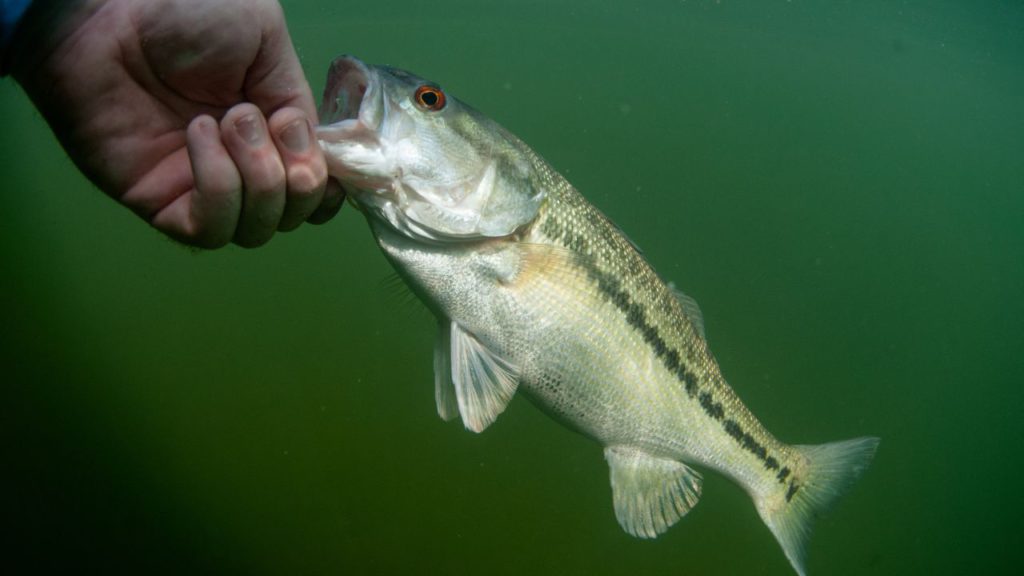
| Scientific Name | Micropterus punctulatus |
| Other Names | Kentucky Spotted Bass, Spotted Black Bass |
| Appearance | Similar coloration to Guadalupe bass though doesn’t extend as low on the body, rows of dark spots on lower sides |
| Average weight and length | 2-3 pounds and 11-24 inches |
| Habitat | Mountain streams, rivers and reservoirs, rocky coves and inlets |
| Range | Lower Mississippi River basin, Ohio River basin, Texas to Florida, and South Carolina |
| Spawning Season | May and June |
| Conservation Status | Established in most locations |
The Spotted Bass is a unique species of bass that is often mistaken for Largemouth because of their similar coloration. However, Spotted Bass prefer water with a current stronger than Largemouth can tolerate, and warmer than Smallmouth prefers. They also have a higher tolerance for sediment and silty waters than other fish.
They’re not as numerous as Largemouth and are often much smaller, but they have powerful bodies which make them fierce fish to fight. It’s best to use light tackle when fishing for them. Some popular lures to use are jigs, small plastic worms, crayfish, and crankbaits.
Suwannee Bass
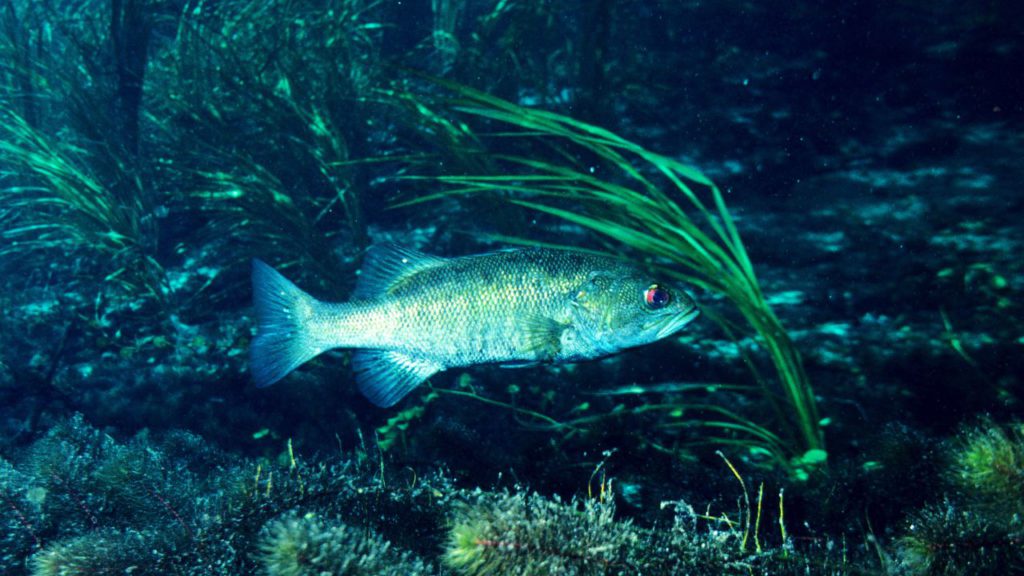
| Scientific Name | Micropterus notius |
| Other Names | NA |
| Appearance | Turquoise coloring on cheeks, belly, and breast, the jaw doesn’t extend past eyes, dark blotches down lateral line |
| Average weight and length | 8-14 inches and under 6 ounces-1.5 pounds |
| Habitat | Rivers and streams, around limestone and woody structures |
| Range | Florida and Georgia |
| Spawning Season | February-June |
| Conservation Status | Special concern |
This rare and small bass, the Suwannee Bass, has a limited range consisting of various rivers and streams in Florida and Georgia. They prefer moderate or swift currents with a mixture of rock and woody structures. This is the perfect habitat for them to feed on crayfish during their spawning season.
This fish rarely exceeds two pounds or a length of 12 inches, making them smaller in comparison to the Florida Bass. However, they’re still a fun fish to catch especially on light tackle. You can use both live bait and artificial to catch them.
Small lures like crayfish jigs, small spinners, plastic worms, and crankbaits are great to use when you want to catch this species of bass.
What Are Temperate Basses?
Temperate bass is also called “sea basses” or “true basses.” They are deep-bodied fish with silvery coloring and often have horizontal stripes on them. They’re a schooling fish, meaning they feed and travel in groups. Some of the temperate basses include White Perch, White Bass, and Striped Bass.
Fun fact: You can find temperate basses in fresh and saltwater.
Yellow Bass

| Scientific Name | Morone mississippiensis |
| Other Names | NA |
| Appearance | Yellow coloration on the belly, several horizontal stripes on the body with the lowest 2 being “broken” towards the posterior |
| Average weight and length | 8-11 ounces and 4-11 inches in length |
| Habitat | Large streams, lakes, and reservoirs steep drop-offs, rock structures, and weed beds |
| Range | Mississippi, Minnesota, Wisconsin, Michigan to Louisiana and Texas |
| Spawning Season | Spring |
| Conservation Status | Established |
The first temperate bass we’re looking at is the Yellow Bass. Often mistaken for White Bass or juvenile Striped Bass, it is on the smaller side of different types of bass.
Light tackle and panfish anglers often target Yellow Bass because of their flaky-white meat. If you want to catch and try its good quality meat, you can use small spoons, spinnerbaits, or even live minnows.
White Bass
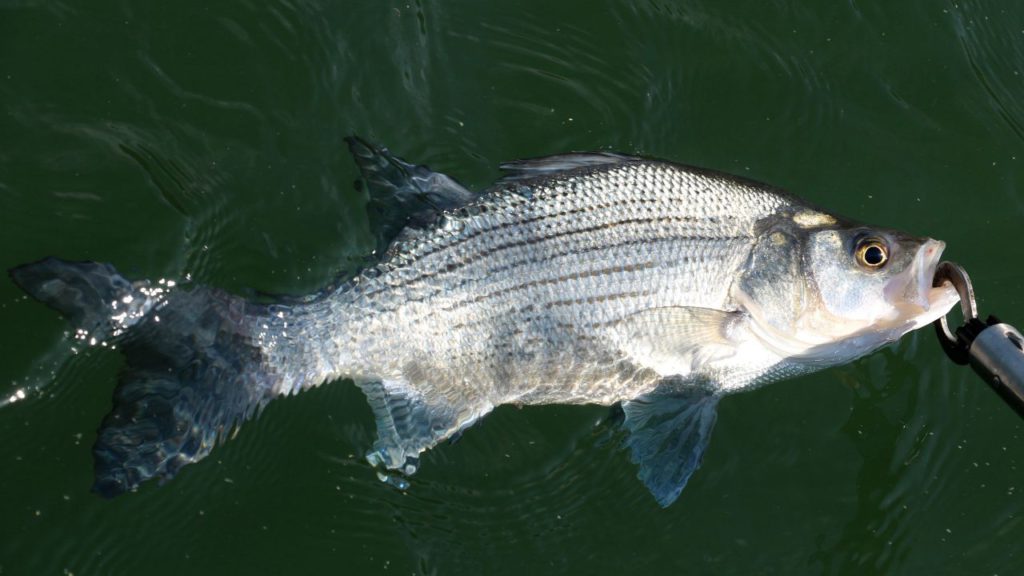
| Scientific Name | Morone chrysops |
| Other Names | NA |
| Appearance | Silver body with several horizontal stripes that fade towards the tail |
| Average weight and length | ½ to 2 pounds and 12-15 inches |
| Habitat | Large rivers with clear, open water |
| Range | Tennessee, West Virginia, South Carolina, Great Lakes region, Hudson Bay, Mississippi, and Ohio, and Louisiana |
| Spawning Season | March-April |
| Conservation Status | Least concern |
White Bass is another small type of bass included in the same genus as Striped Bass, White Perch, and Yellow Bass. They have a vast range throughout the United States and are known to travel a hundred miles in one season.
They are predatory fishes that feed on small fish, insects, and crayfish. You can find them along shorelines and dams when targeting this type of bass.
Anglers will find success using lures like spoons, white spinners, and minnow-mimic crankbaits. Using live minnows is great too. If you plan to target these fish, the best time to catch them is in the early fall and spring.
Striped Bass
| Scientific Name | Morone saxatilis |
| Other Names | Striper, Linesider, Rockfish |
| Appearance | White/silvery iridescent underside, with olive, light green, steel blue or black on top and 7-8 horizontal stripes from gills to tail |
| Average weight and length | 3-10 pounds and 20-36 inches |
| Habitat | Major rivers, estuaries, and coastal areas |
| Range | Along Eastcoast from St. Lawrence River to St. Johns River in Florida, and the Gulf of Mexico from Florida to Louisiana |
| Spawning Season | April-May |
| Conservation Status | Protected |
One of the most sought-after species of the temperate basses is the Striped Bass. They are unique and incredible fish that can reach extraordinary sizes — as much as five feet in length and as much as 300 to 60 pounds! Unfortunately, their numbers are dwindling.
White Perch
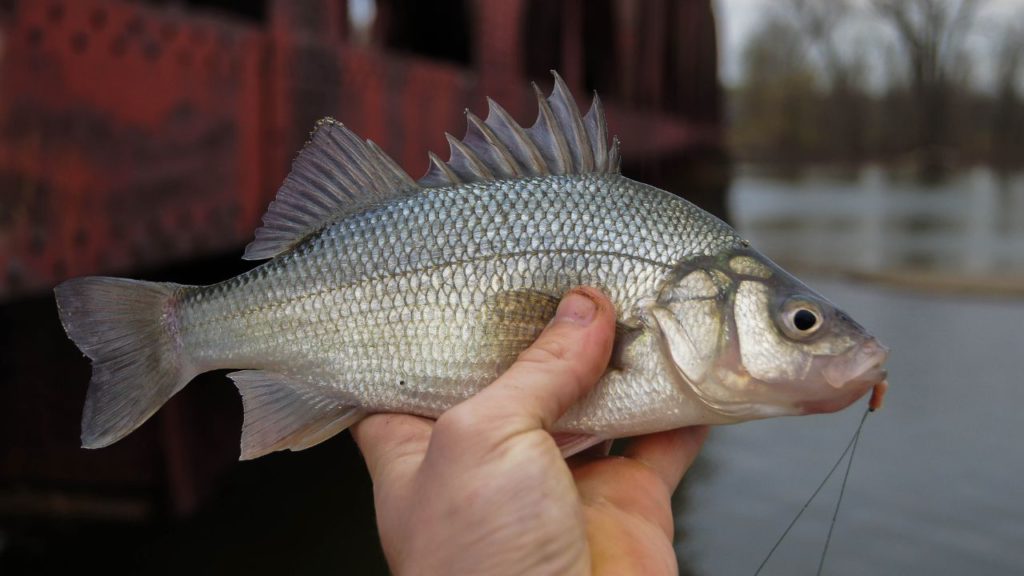
| Scientific Name | Morone americana |
| Other Names | NA |
| Appearance | No stripes, silvery green, or olive on sides, and white silvery underbelly |
| Average weight and length | Approximately 0.45 pounds and 8-10 inches |
| Habitat | Muddy, silty, or sand bottoms, brackish waters and freshwater rivers |
| Range | Along Atlantic coast: South Carolina to St. Lawrence river an up through Nova Scotia and New Brunswick |
| Spawning Season | April-June |
| Conservation Status | Least concern |
White Perch are actually close relatives to White Bass and Striped Bass. As a matter fact, White Perch looks like a White Bass in terms of body shape and appearance. The only difference is that White Perch doesn’t have horizontal stripes.
These fish are highly popular for food and sport. Since they are light tackle fish, you can use a combination of an ultra-light trout rod and a light saltwater spinning reel. In terms of bait, you can opt for small spinners, spoons, and jigs.
Last Cast of the Day for Different Types of Bass
There is so many different types of bass across the United States. Although they may look the same, key physical features set them apart from one another. Remember that they also have different fishing regulations. Happy Bass Fishing!
Table of Contents



